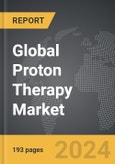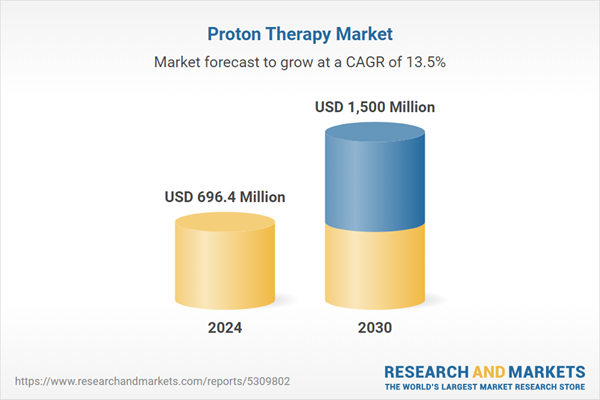Global Proton Therapy Market - Key Trends and Drivers Summarized
Targeting Cancer with Precision: The Growing Market for Proton Therapy
Proton therapy is a cutting-edge form of radiation therapy that is transforming the way cancer is treated, offering a highly precise and effective option for targeting tumors. Unlike conventional X-ray radiation, which can damage surrounding healthy tissues, proton therapy uses charged particles (protons) that deliver their maximum energy directly to the tumor site, minimizing collateral damage to adjacent healthy cells. This precision makes proton therapy particularly valuable in treating tumors located near critical structures, such as the brain, spine, and eyes, where conventional radiation could cause significant side effects. As cancer treatment becomes increasingly focused on precision and personalized care, proton therapy is gaining recognition as a superior option for many patients, especially children and those with complex cases.How Are Technological Advancements Enhancing Proton Therapy?
Technological advancements have played a pivotal role in the expansion and improvement of proton therapy. Innovations in imaging technologies, such as MRI and CT-based planning, have significantly enhanced the accuracy of proton beam delivery, allowing clinicians to better visualize tumors and plan treatments with pinpoint precision. The development of pencil beam scanning (PBS) technology has further improved the precision of proton therapy by enabling the delivery of highly focused beams that can conform to the exact shape of the tumor, reducing the dose to surrounding healthy tissues. Additionally, advancements in accelerator technology have made proton therapy more accessible by reducing the size and cost of treatment facilities. These technological improvements are making proton therapy a more viable and attractive option for cancer treatment centers around the world.What Are the Expanding Applications of Proton Therapy?
The applications of proton therapy are expanding as more clinical evidence supports its efficacy in treating a wide range of cancers. While traditionally used for pediatric cancers and tumors near critical structures, proton therapy is now being explored for use in treating breast, lung, and gastrointestinal cancers, where minimizing radiation exposure to surrounding tissues is crucial. The potential for proton therapy to reduce long-term side effects and improve the quality of life for cancer survivors is also driving its adoption in the treatment of head and neck cancers, where traditional radiation can cause significant damage to critical organs such as the salivary glands and vocal cords. Additionally, ongoing research is investigating the use of proton therapy in combination with other treatments, such as immunotherapy and chemotherapy, to enhance overall treatment outcomes. These expanding applications are broadening the scope of proton therapy in cancer care.What Are the Key Growth Drivers in the Market?
The growth in the proton therapy market is driven by several factors. The increasing incidence of cancer worldwide is a major driver, as the demand for advanced, precise, and effective treatment options continues to rise. Technological advancements in imaging, beam delivery, and accelerator design have significantly improved the accessibility and efficacy of proton therapy, making it a more attractive option for treatment centers. The expanding range of cancers that can be treated with proton therapy, coupled with the growing body of clinical evidence supporting its benefits, is also driving adoption. Additionally, the increasing focus on personalized and precision medicine is encouraging the use of proton therapy, particularly in cases where traditional radiation could cause significant side effects. As the global healthcare community continues to prioritize patient-centered care, the demand for proton therapy is expected to grow substantially.Report Scope
The report analyzes the Proton Therapy market, presented in terms of market value (USD). The analysis covers the key segments and geographic regions outlined below.- Segments: Product (Accelerators, Beam Delivery Systems, Beam Transport Systems, Other Products); Indication (CNS Cancer, Prostate Cancer, Head & Neck Cancer, Breast Cancer, Other Indications); End-Use (Hospitals, Proton Therapy Centers, Other End-Uses).
- Geographic Regions/Countries: World; United States; Canada; Japan; China; Europe (France; Germany; Italy; United Kingdom; and Rest of Europe); Asia-Pacific; Rest of World.
Key Insights:
- Market Growth: Understand the significant growth trajectory of the Accelerators segment, which is expected to reach US$843.6 Million by 2030 with a CAGR of 13.7%. The Beam Delivery Systems segment is also set to grow at 14.2% CAGR over the analysis period.
- Regional Analysis: Gain insights into the U.S. market, valued at $190.4 Million in 2024, and China, forecasted to grow at an impressive 12.5% CAGR to reach $223.8 Million by 2030. Discover growth trends in other key regions, including Japan, Canada, Germany, and the Asia-Pacific.
Why You Should Buy This Report:
- Detailed Market Analysis: Access a thorough analysis of the Global Proton Therapy Market, covering all major geographic regions and market segments.
- Competitive Insights: Get an overview of the competitive landscape, including the market presence of major players across different geographies.
- Future Trends and Drivers: Understand the key trends and drivers shaping the future of the Global Proton Therapy Market.
- Actionable Insights: Benefit from actionable insights that can help you identify new revenue opportunities and make strategic business decisions.
Key Questions Answered:
- How is the Global Proton Therapy Market expected to evolve by 2030?
- What are the main drivers and restraints affecting the market?
- Which market segments will grow the most over the forecast period?
- How will market shares for different regions and segments change by 2030?
- Who are the leading players in the market, and what are their prospects?
Report Features:
- Comprehensive Market Data: Independent analysis of annual sales and market forecasts in US$ Million from 2024 to 2030.
- In-Depth Regional Analysis: Detailed insights into key markets, including the U.S., China, Japan, Canada, Europe, Asia-Pacific, Latin America, Middle East, and Africa.
- Company Profiles: Coverage of players such as Advanced Oncotherapy Plc, Hitachi Ltd., Ion Beam Applications SA, Koninklijke Philips NV, Mevion Medical Systems, Inc. and more.
- Complimentary Updates: Receive free report updates for one year to keep you informed of the latest market developments.
Some of the 43 companies featured in this Proton Therapy market report include:
- Advanced Oncotherapy Plc
- Hitachi Ltd.
- Ion Beam Applications SA
- Koninklijke Philips NV
- Mevion Medical Systems, Inc.
- Mitsubishi Corporation
- Optivus Proton Therapy, Inc.
- Protom International
- Sumitomo Heavy Industries Ltd.
- Varian Medical Systems, Inc.
This edition integrates the latest global trade and economic shifts into comprehensive market analysis. Key updates include:
- Tariff and Trade Impact: Insights into global tariff negotiations across 180+ countries, with analysis of supply chain turbulence, sourcing disruptions, and geographic realignment. Special focus on 2025 as a pivotal year for trade tensions, including updated perspectives on the Trump-era tariffs.
- Adjusted Forecasts and Analytics: Revised global and regional market forecasts through 2030, incorporating tariff effects, economic uncertainty, and structural changes in globalization. Includes historical analysis from 2015 to 2023.
- Strategic Market Dynamics: Evaluation of revised market prospects, regional outlooks, and key economic indicators such as population and urbanization trends.
- Innovation & Technology Trends: Latest developments in product and process innovation, emerging technologies, and key industry drivers shaping the competitive landscape.
- Competitive Intelligence: Updated global market share estimates for 2025, competitive positioning of major players (Strong/Active/Niche/Trivial), and refined focus on leading global brands and core players.
- Expert Insight & Commentary: Strategic analysis from economists, trade experts, and domain specialists to contextualize market shifts and identify emerging opportunities.
Table of Contents
Companies Mentioned (Partial List)
A selection of companies mentioned in this report includes, but is not limited to:
- Advanced Oncotherapy Plc
- Hitachi Ltd.
- Ion Beam Applications SA
- Koninklijke Philips NV
- Mevion Medical Systems, Inc.
- Mitsubishi Corporation
- Optivus Proton Therapy, Inc.
- Protom International
- Sumitomo Heavy Industries Ltd.
- Varian Medical Systems, Inc.
Table Information
| Report Attribute | Details |
|---|---|
| No. of Pages | 193 |
| Published | October 2025 |
| Forecast Period | 2024 - 2030 |
| Estimated Market Value ( USD | $ 696.4 Million |
| Forecasted Market Value ( USD | $ 1500 Million |
| Compound Annual Growth Rate | 13.5% |
| Regions Covered | Global |









